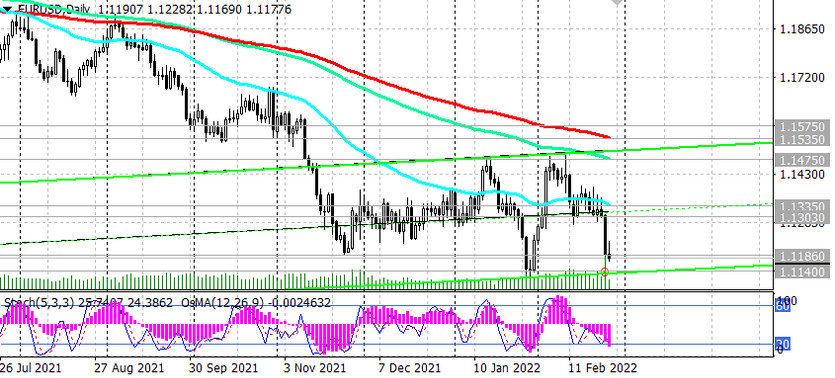Events in Ukraine continue to be the focus of investors' attention, remaining the main driver of the financial market dynamics over the past few days. Investors fear that the Russian-Ukrainian conflict will accelerate inflation to new highs, while the price of a barrel of oil is hovering around $100. Europe is especially vulnerable in the current situation, given its dependence on Russian energy sources.
Inflation in the Eurozone hit a record high in January, half driven by energy prices, according to the European Central Bank. The data published the day before indicated that the inflation rate at the beginning of the year is kept near the 5.1% mark. But the ECB still maintains a loose monetary policy, and also continues the quantitative easing program.
While the probability of a March rate hike by the Fed by half a percentage point was estimated by investors at 41%, the ECB is more restrained. Regulator President Christine Lagarde said she plans to gradually normalize monetary policy. The conflict in Ukraine and disruptions in energy supplies to Europe could put pressure on the growth rate of the Eurozone economy, which could force the ECB to pursue stimulus policies longer, economists say. In their opinion, if there is a further escalation of the conflict in Ukraine, this will negatively affect consumer income in the event of a prolonged rise in energy prices and harm economic growth. Thus, the representative of France in the leadership of the ECB recently said that the regulator is closely monitoring the situation in Ukraine and intends to adhere to a flexible approach to monetary policy. If the European Central Bank is taking a less aggressive stance on monetary tightening, then Fed officials believe that now is the right time to raise interest rates. For example, San Francisco Fed President Mary Daly said on Wednesday that she still supports the idea of raising them at the central bank's March meeting. "It's time to roll back the Fed's emergency support during the pandemic and align monetary policy with current challenges", she said. "Based on no major unpleasant surprises, I believe our next meeting in March would be an opportune moment to begin this adjustment". Fed Governor Christopher Waller said on Thursday that he favors a 0.5 percentage point hike in the key interest rate in March amid growing inflation concerns. "We constantly say that we have the tools to fight inflation, and now we must demonstrate the willingness to apply them," Waller said. In his opinion, inflation is "too high, it should be lowered".
Today (11:15 GMT) ECB President Lagarde is scheduled to speak, and at 13:30 (GMT) a block of important US macro statistics will be published. Other data includes orders for durable goods and orders for capital goods (excluding defense and aviation).
Capital goods are durable goods used to produce durable goods and services that involve large investments. Forecast for January: +0.8% (durable goods orders), +0.5% (capital goods orders, excluding defense and aviation). The data is likely to have a positive impact on the dollar if the forecast is confirmed. Data worse than the previous value and/or the forecast will have a negative impact on dollar quotes.
In January, the annual inflation rate in the US hit a 40-year high of 7.5%. Higher inflation was mainly driven by strong demand for goods, supply chain problems and shortages of some intermediate goods, but service prices accelerated as well. If inflation and employment data coming out before the next meeting "show that the economy is still overheated, that would be an important reason to raise rates in March (by 0.5 percentage points)", Fed Governor Christopher Waller said.
Meanwhile, the dollar retains its leadership in the current situation, also actively using the status of a defensive asset. For example, DXY futures are currently traded near 97.17, down from yesterday's 19-month high of 97.73. Obviously, the dollar has room for further strengthening both against the backdrop of the Fed's position on monetary policy, and against the backdrop of the ongoing military conflict in Europe (between Russia and Ukraine).
As for the EUR/USD pair, it is developing a downward trend, being in the bear market zone, moving towards the lower border of the downward channel on the weekly chart and 1.1000, 1.0900 marks.






